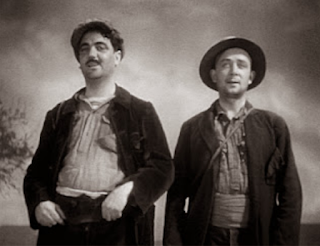arbeit macht frei
by Douglas Messerli
René Clair (screenwriter and director) À Nous la Liberté (Freedom
for Us) / 1931
Liberty is the happy
man’s due
He enjoys love and
skies of blue
But then there are
some
Who no worse crimes
have done
It’s a sad story we
tell
From a prison cell
The comic interlude that follows is as
good or better as anything Chaplin, one of Clair’s favorite filmmakers, might
have created, as the escaped prisoner accidentally knocks a bicyclist
participating in a bicycle race off his vehicle, putting himself in the
position of racing on the bike—mostly to escape the police—over the finishing
line to win the race.
Louis, in fact, quickly appears to be a
winner, successfully robbing a local store, and, after finding temporary
employment in a record store, becoming a wealthy industrialist who owns several
factories that produce phonograph players.
Although Louis has achieved wealth, his
workers are even worse off than the prisoners on the assembly line, as Clair,
combining images that might remind one of Fritz Lang’s Metropolis of
five years previous with humorous factory scenes that Chaplin would openly
steal in his Modern Times, which premiered five years later. So similar
are the worlds of the prison and in the factory—where a Guard, noticing a
slacker, shouts: “Not at work? Don’t you know that….” To which the factory
worker answers “…work is mandatory. Because work means liberty”—that, in
hindsight, we only link it with the German-inspired phrase, “Arbeit macht
frei,” which cynically greeted prisoners and Jews to the concentration camps of
Auschwitz, Sachsenhausen, Theresienstadt, Dauchau, and other notorious
institutions of death only two years after Clair’s comic film.
Work in this world not only does not result in “liberty,” but enslaves
the willing participants and the factory owners alike. Suddenly freed from
imprisonment, Ėmile, resting peacefully in the countryside, is roused by the
police and forced into labor as if he had never left his cell. Like Chaplin’s
tramp, he fouls up the well-oiled machine, intruding upon another worker’s
space as he has missed the opportunity to screw into the phonograph a needed
bolt, causing a near riot, as, bothered by Ėmile’s intrusion into his space,
the second also is unable to accomplish his task, the third, the fourth and so
on, until the entire factory breaks down in the process.
Ėmile also bollixes up the factory
hierarchy by falling quickly in love with the manager’s niece, Jeanne, leading,
after a couple of attempted meetings with the girl, to another chase which ends
with an encounter with the owner—his former prison mate! Fearing blackmail,
Louis tries to offer him money, which the honest Ėmile refuses, shaming his
former comrade.
Relieved by the mass exit of his guests,
Louis joyfully dances with Ėmile, while sending a missile of a wine bottle into
his own portrait, clearly demonstrating his disgust of his current life.
Equally delighted by his wife’s morning
departure, Louis does not recognize an ex-prisoner in the street, a man who,
however, perceives him. More comic events follow, including Louis’ attempt to
marry off Ėmile to Jeanne and a group of gangsters’ (all ex-prisoners) attempt
to “out” Louis as a former prisoner. Gang members chase Louis (who has gathered
all his savings in a suitcase) and cops chase behind—again demonstrating
Clair’s love of Mack Sennett, Chaplin and Keaton shorts—which all ends where we
know it must: with the two “comrades” taking once more to the road, enjoying
each other in their simple roles as vagabonds more than the world of work and
regimentation.
In the end, Clair reveals that these two
can be free only without the societal pressures. The light-hearted songs the
men and others sing throughout are all lies. The true joy exists in their
camaraderie and idleness. Obviously, the “liberty” which these men were
originally seeking, their freedom from jail, also came to encompass freedom
from the strictures of patriarchal duties which both Louis and Ėmile have
attempted to emulate, Louis more successfully than his friend. But by the end
of this “buddy” film the “willing” reader also recognizes that that the
“liberty” these men seek is an escape from the more specific heteronormative
imprisonments of marriage and heterosexual sex. And in that sense, this film
bears an odd relationship—almost serving as a solution to—the relationship
between the two developed in the prison as played out quite differently in
William Dieterle’s movie, Sex in Chains of three years earlier as well
as presaging
Given the more coded issues and very
obvious social issues that were occurring throughout Europe at the moment of
Clair’s farce, his work may have been far more radical than Clair even intended
it. For only a few years later these two would surely have arrested for
vagrancy, imprisoned, overworked and, perhaps, killed. But for an idyllic
moment this Flaubertian, Beckettian, and Laurel and Hardy-like couple, for once
in their lives, were truly free, of which Ėmile reminds his partner with a
good, swift kick in the pants. If Clair’s film, so beloved in its day, has lost
its significance as the years have passed, it is only because the horrors of
World War II could no longer permit theater-goers to laugh at the absurd logic
behind the terror that would follow.
Los Angeles, November 17, 2013
Reprinted from World Cinema Review (November 2013).







No comments:
Post a Comment